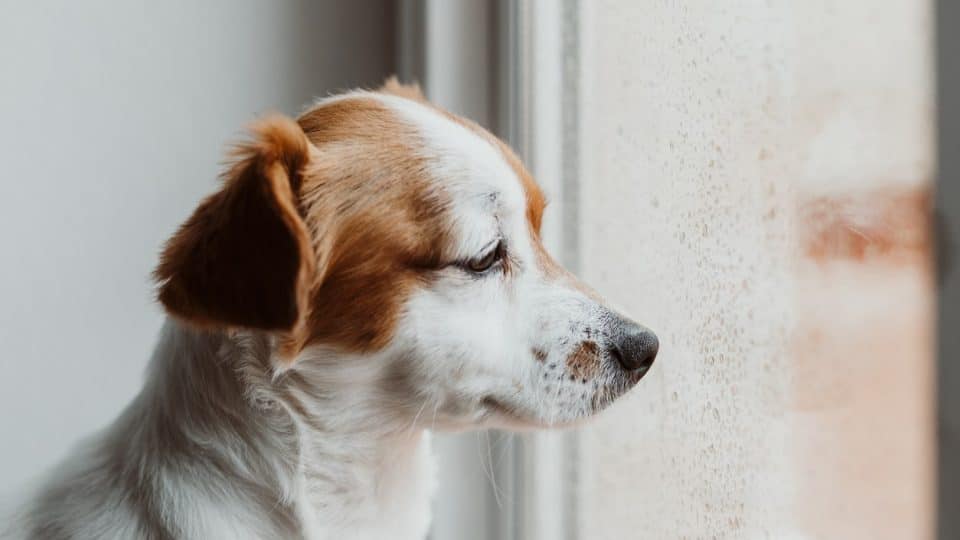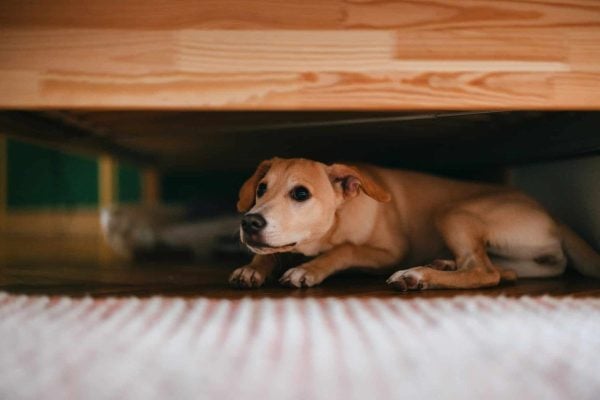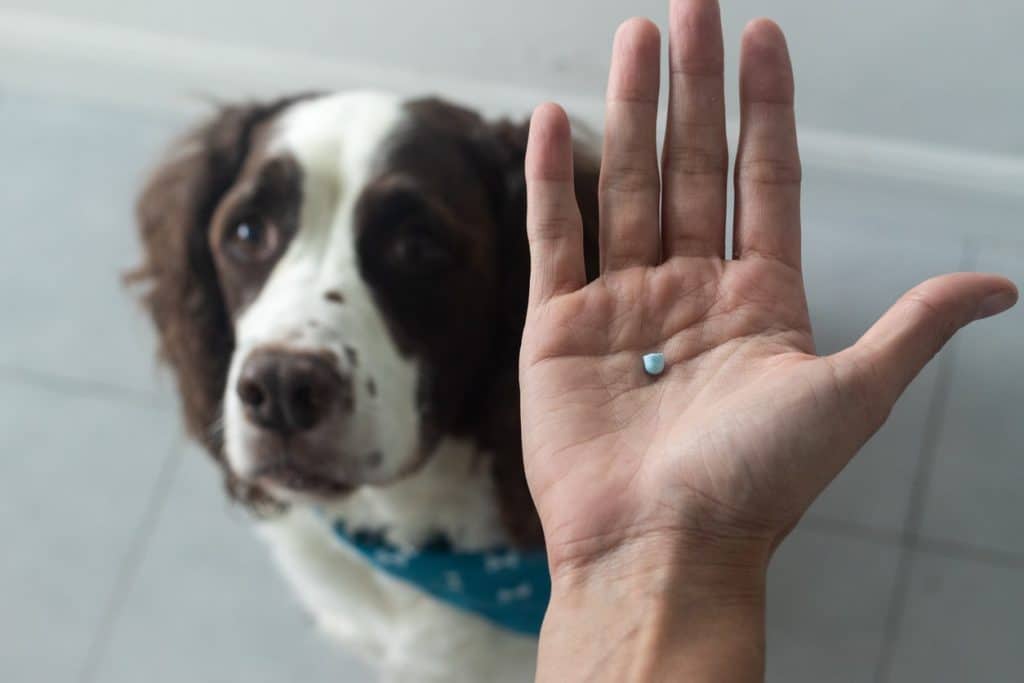- Not a substitute for professional veterinary help.
If your dog paces, pants, or hides when they hear heavy rain or sounds of thunder, they may have storm anxiety, or a fear of thunderstorms.
Thunderstorm phobia, or astraphobia, is fairly common in dogs. Dogs with this type of anxiety may also have a general sensitivity to noises or a fear of fireworks and other booming sounds.
Dogs can develop storm phobia for many reasons, according to Dr. Brad Hinsperger, veterinarian at Kingsdale Animal Hospital. He says this may affect dogs who:
- Have sensitive hearing that makes sounds even louder
- Feel uncomfortable tingling, due to static electricity in their fur
- Notice air pressure changes that happen before a storm
- Have negative memories and trauma due to past experiences with storms or loud noises
Read on to learn more signs of storm phobia in dogs, home remedies for dogs with a fear of thunder, and when to consult a vet.
Signs Your Dog Is Afraid of Thunder
Dogs may become anxious when they notice signs of an approaching storm and when lightning and thunder actually happen, says Dr. Denise Johnson, veterinarian and certified canine behavior counselor.
A fear of storms can cause:
- Trembling or shaking
- Tucking the tail under the body
- Frequent yawning
- Panting
- Drooling
- Sweaty paws
- Whining
- Howling
- Pinned or flattened ears
- Licking the air
- Hiding away from the noise, like in a closet
These symptoms are similar to the ones dogs with general anxiety might experience. However, they’ll happen specifically when dogs anticipate or hear sounds of thunder or rain.
How To Calm a Dog During a Thunderstorm
You can do a lot to help a dog scared of thunder. Helpful home remedies for docs scared of thunder include anxiety jackets, calming pheromones, and safe spaces.
To find the best approach for your dog, it may help to try just one or two of the strategies below at a time. Then, add others and make changes as needed until you notice improvement.
Stay calm
Dogs can pick up on your emotions, explains Dr. Jennifer E. Feeney, veterinarian and behavior analyst with Better Bond Behavior.
Staying calm is key to helping your dog feel comfortable, since they can tell if you feel stressed. If needed, try taking some deep breaths to slow your heart rate and feel more settled.
Dr. Feeney suggests talking to your dog like you would a friend. Avoid baby talk or a high-pitched voice. Instead, use a quiet tone to tell them there’s nothing to worry about.
Allow your dog to choose a safe space
Letting your dog choose where they want to hang out during a storm can help them feel more secure and in control in an otherwise stressful situation.
You can offer your dog a few safe spaces to choose from, like their crate, a comfortable space in a closet, or a similar area. They may also prefer to stay near you.
A quiet room without windows is usually ideal, says Dr. Heather Berst, a veterinary medical doctor and medical lead at Zoetis.
Wherever your dog chooses to be, Drs. Feeney and Johnson suggest providing them with:
- A cozy bed
- Interactive puzzle toys
- A shirt or other item that smells like you
Play soothing sounds
The sounds of thunder and heavy rain often trigger a dog’s fear of storms. Playing soothing sounds can help drown out these noises so your dog feels calmer.
Dr. Berst recommends playing soft music or some soothing sounds on the TV or a noise machine. You can also speak to your dog in a calm voice to distract and comfort them.
Tip: When speaking to them, get low on their level instead of towering over them, as this could increase their stress.
Use calming pheromones
Calming pheromones are species-specific chemical signals that send comforting messages and support calmness.
”There are several brands of pheromones to help dogs feel calm,” Dr. Feeney says. For example, ThunderEase makes a calming spray, collar, and diffuser kit that can help treat dog storm anxiety.
Dr. Johnson also recommends Adaptil or Zenodog. These products provide ongoing support for dogs facing unpredictable storms or other sources of stress, like separation from their people.
Try an anxiety jacket
An anxiety jacket is a wrap that provides constant, mild pressure around your dog’s torso to help soothe them.
Dr. Johnson says Thundershirts and other anxiety wraps work best for dogs who seek out contact when stressed.
According to one small study, anxiety wraps can help reduce the severity of clinical anxiety symptoms by almost 50%. Pet parents said their dogs didn’t experience any negative effects from the anxiety wrap.
You can use an anxiety jacket or a ThunderShirt for your dog when you know a storm’s coming. That said, it’s important to get your dog used to wearing it beforehand to make sure they’re comfortable with it.
Have them wear the jacket or wrap for a few minutes every day, giving them treats and praise to create a positive association.
Offer high-value distractions
Some dogs who are scared of thunder might respond well to a distraction, like a favorite food or toy.
Dr. Feeney suggests that if your dog is food-driven, choose a high-value treat, such as cheese on a lick mat or peanut butter in a Kong toy. This will give them something to focus on other than the storm.
You might also offer a fun squeaky toy or play a game of fetch or tug-of-war. However, Dr. Feeney recommends only doing this if your dog would typically be interested in these activities.
How To Prepare Your Dog for Thunder
You can start helping your dog cope with thunderstorms long before the first rumble. Taking action ahead of time can help make storms more manageable for you and your pup.
Know when storms are coming
Paying attention to the weather forecast can help you plan ahead for storms. For example, you can have calming sounds ready and know when to stay home with your dog if possible.
Storm Shield is a mobile app that allows you to enable alerts for thunderstorms, tornadoes, hurricanes, and other weather events.
Desensitize your dog to storm sounds
If your dog is scared of a particular sound, like thunder or rain, you may be able to desensitize them to these sounds.
One approach might involve finding a storm playlist on YouTube. Start at a low volume and gradually increase the volume as your dog gets used to it. Eventually, the sounds may no longer bother them.
Important: If desensitization isn’t done correctly, it can create more stress for your dog, Dr. Berst explains. Desensitization won’t work for every dog, either. It’s always best to talk to your vet for guidance before you try this approach.
Ask your vet about medication
In some cases, medication may help alleviate stress-related symptoms caused by thunder. Anti-anxiety medications for dogs include Xanax and Trazodone.
You can give your dog prescription medication 60 to 90 minutes before a storm to decrease the physiologic response to their fear.
These medications can help ease a pounding heart and other fight-or-flight stressors caused by signs of a storm.
Learn dog body language
Dogs use their body language to communicate with people, Dr. Feeney says, adding that it’s far more important to learn how to understand body language than sounds like barking or whining.
Knowing what your dog’s body position means will help you better understand them and their emotions. For example, pinned-back ears or a tucked tail often means they’re scared or anxious.
Dr. Feeney suggests giving your dog space if you notice fearful body language, since they may react with aggression if you get too close.
Can Dogs Become Less Afraid of Thunderstorms?
With proper treatment, love, and support, your dog may become less scared of thunderstorms over time.
Desensitization training and counter conditioning can take anywhere from a few months to several years, depending on how often you can practice these techniques with your dog. However, some dogs may experience lifelong storm phobia, Dr. Feeney says.
If your dog’s storm anxiety seems severe or doesn’t improve with home remedies, it’s best to make an appointment with your vet. They can advise you on the best treatment plan and may prescribe an anti-anxiety medication, which Dr. Feeney says can make a big difference for your dog’s well-being.





